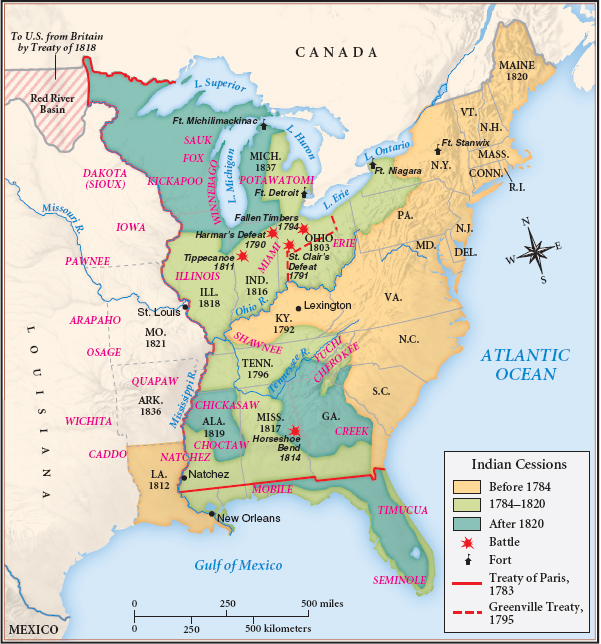AP-Style Short Answer Questions for Part 3
1. Historians agree that the ideas of the Enlightenment helped to spur the American Patriots’ resistance to Britain’s actions between 1763 and 1776, and that they lay at the foundation of the governments Americans established once the colonies declared their independence. Use your knowledge of United States history to answer parts A, B, and C.
A) Identify and briefly explain ONE way that Enlightenment ideas manifest in the U.S. Constitution.
B) Briefly identify ONE specific group of Americans and explain how the element you identified in part A provided concrete benefits to that group.
C) Briefly identify ONE specific group of Americans who did not benefit from the element you identified in part A and explain why they were exempt from its advantages.
Question 103.1
2. Question 2 is based on Map 7.2: Indian Cessions and State Formation, 1776–1840.

Use your knowledge of United States history and Map 7.2 to answer parts A, B, and C.
A) Briefly identify and explain ONE way that processes illustrated on this map related to Thomas Jefferson’s agrarian vision for the new American republic.
B) Briefly identify and explain ONE way that the processes illustrated on this map advanced Alexander Hamilton’s commercial vision for the new American republic.
C) Briefly identify and explain ONE way that the processes illustrated on this map precipitated a major conflict in the United States between 1776 and 1840.
Question 103.2
3. Use your knowledge of United States history and the following excerpt to answer parts A, B, and C.
Mr. Neal (from Kittery) [an Antifederalist] went over the ground of objection to . . . the idea that slave trade was allowed to be continued for 20 years. His profession, he said, obliged him to bear witness against any thing that should favor the making merchandize of the bodies of men, and unless his objection was removed, he could not put his hand to the constitution. . . .
Mr. Heath (Federalist): . . . I apprehend that it is not in our power to do any thing for or against those who are in slavery in the southern states. No gentleman within these walls detests every idea of slavery more than I do: it is generally detested by the people of this commonwealth, and I ardently hope that the time will soon come, when our brethren in the southern states will view it as we do, and put a stop to it; but to this we have no right to compel them.
Two questions naturally arise: if we ratify the Constitution, shall we do any thing by our act to hold the blacks in slavery or shall we become the partakers of other men’s sins? I think neither of them: each state is sovereign and independent to a certain degree, and they have a right, and will regulate their own internal affairs, as to themselves appears proper. . . . We are not in this case partakers of other men’s sins. . . .
Source: Jonathan Elliot, ed., The Debates . . . on the Adoption of the Federal Constitution (1836)
A) Identify a point of view represented in this excerpt regarding ONE of the following:
States’ rights
Federal government
B) Explain how ONE argument in the excerpt expresses the point of view you identified.
C) Explain how the point of view you identified in part A contributed to ONE specific government action between 1776 and 1840.
Question 103.3
4. Question 4 is based on the following two passages.
“The movement for the Constitution of the United States was originated and carried through principally by four groups . . . which had been adversely affected under the Articles of Confederation: money, public securities, manufactures, and trade and shipping. The first firm steps toward the formation of the Constitution were taken by a small and active group of men immediately interested through their personal possessions in the outcome of their labors. . . . The members of the Philadelphia Convention . . . derived economic advantages from the establishment of the new system. The Constitution was essentially an economic document based upon the concept that the fundamental private rights of property are anterior to government and morally beyond the reach of popular majorities.”
Charles Beard, An Economic Interpretation of the Constitution of the United States, 1913
“The Constitution was the product of many compromises. Federalists were thus able to promote it by appealing to interest groups that were supposed to be beneficiaries. Slavery was protected; small states gained equality in the Senate; merchants would benefit from a coherent commercial policy. . . . The Constitution could be all things to all people because all things were possible to those who would believe them so. The success of the Constitution was grounded on faith, or on what contemporaries would call ‘virtue.’ Americans experienced a rapid inflation of power under the Constitution because they accepted the legitimacy of power. . . . But its greatest accomplishment was to articulate an underlying consensus about what the American union should be like.”
Peter Onuf, Origins of the Federal Republic: Jurisdictional Controversies in the United States, 1775–1787, published in 1983
Using your knowledge of U.S. history and the two excerpts above, answer parts A, B, and C.
A) Briefly explain the major difference between Beard’s and Onuf’s interpretations of the Constitution.
B) Explain ONE specific piece of evidence that supports Onuf’s interpretation.
C) Account for the differences between Beard’s and Onuf’s arguments.